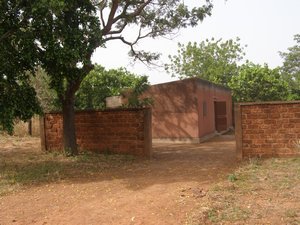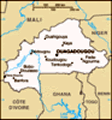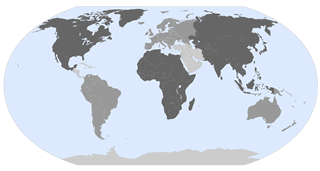Advertisement
Published: December 6th 2009

 White Fathers Mission
White Fathers Mission
This is the guest house where we stayed…Burkina Faso Continued
After departing the Ste. Cecile orphanage, we returned to Samagan, the White Father mission where Jacques lives. The White Fathers, as they are called, are the Missionaries of Africa organization. They are nicknamed White Fathers due to the distinctive white robes they wear. They are stationed in over 20 African countries to live and integrate within the communities and be witnesses of God. The gentlemen who become White Fathers come from around the world including Mexico, India, Rwanda, Nigeria, Burundi, Congo and elsewhere. They spend nine years training to be ordained as a White Father. As part of that training they must learn another language, to show that they are adaptable and able to integrate into a community.
We spent three days at Samagan dining with the students and the White Fathers. The six of us split up with two each going to a different table for each meal. We would spend meal time asking questions and providing answers to each other. Following each meal we joined them with the clean-up and took up a dish drying role. The kids enjoyed helping out.
One evening, was a special anniversary of the founding for the organization
(founded by Cardinal Lavigerie in early 1900s). There was a special mass we attended in the Samagan chapel. We were a bit in awe of being in attendance at a mass with 10 White Fathers and 28 students training to be White Fathers…this was not your ordinary congregation. Following mass was a special dinner, and following clean-up there were skits prepared by each of the teams (the 28 are divided into about 5 teams) with the common theme of the founding of the White Fathers organization.
On our last evening we were invited to sit with Jacques’ team for a weekly sharing discussion. The common language for the White Fathers is french. This is in addition to the native languages each person also speaks. This one evening each member of Jacques team had done some preparation to do their discussions in English, as a way to practice that language and involve me. It was a wonderful evening where we learned a bit more about where everyone comes from and the White Fathers’ organization. They were also very interested in our round the world tour. We explained how we are able to do this and how we are working the
schooling. It was enjoyable.
You can tell a lot about an organization, based on the quality of the people involved in that organization. We can testify that the White Fathers organization is quality of the highest degree. These young gentlemen who are training to be missionaries are exceptional individuals. Beginning with Jacques Charron, the White Fathers who lead them are truly wonderful men. I cannot have picked a finer place to insert my family for several days than Samagan, and for that we are incredibly appreciative to Jacques and everyone at Samagan for the experience and wish them blessings in their important future endeavors. Jacques would continue to be our guide for the next few days as we visit some of Burkina Faso’s most magnificent spots.
After Samagan, we returned to Ouagadougou and our home base the Azaaba B&B and our hosts Christophe and Nicolas. Ouaga is a very busy city. The people are up very early (seeing as many sleep in front of their shops, this is not surprising), and the vendors are sharp and surrounding your car at first light. The Burkinabes, as I indicated in the last blog, are very friendly. There is a slow
pace to everything, and it is no wonder with the daily heat they have to bear. They are very easy going and relationships are everything. They establish relationships for social status, to support their businesses, and to obtain the needs they have for the family. There is absolutely no pretensions and no obsession for acquiring material goods as we have in North America. When asked what they thought of Burkina Faso, a couple of the boys thought it was very poor. Perhaps it is when compared to our materialistic society, but the Burkinabes are very comfortable in their own skin and with the daily lives they live. They do not complain that they have to go to the neighbors to use the toilet…but they do question how they are going to pay for their kids to go to school. It is a rich culture.
There is a certain freedom to the way they live. You can stand on a street corner here at anytime, look in all four directions, and find at least 10 things being done that would violate the law in Canada. Cooking food in huts to sell, overloaded trucks, dangerous mopeds with bare feet inches away
from fast moving gears and chains, burning fires in the street…and so much more. They have no big brother looking over their shoulders to tell them what they can and cannot do. What they do have however are some very old traditions that are very much alive…especially in the rural parts of the country. For instance, women are viewed as being the providers of life and their role in society is along those lines and are the only ones that can make the to (their main meal). The politics in many African countries is still scary…I read ‘Memoirs of a Child Soldier’, and it freaked me out to read how shaky peace can be and how evil we can be as a race.
I mentioned how well dressed the women and men are. I neglected to mention the children, who typically have a school uniform they wear. I am starting to get an inferiority complex as even the school uniforms are nicer than my clothes.
There are many more cars in the Ouagadougou and Bobo than in other cities and towns in the country. The Burkinabes must be naturally gifted mechanics, because most of the cars are old
dilapidated cars that look as though they were plucked off the top of the junk yard pile…however, I don’t think any car is junked here. In fact, many used vehicles from Europe arrive here to be sold…so they start off in rough shape. Somehow the Burkinabes find a way to get and keep them going. We took a couple of cabs and these vehicles were more than suspect in our confidence in their capability to get us to where we were going…but they did. They have a shared taxi/bus service that travels between towns…these things are small passenger vans probably with the capability of seating 15 people. These things are wrecks! It is very common to see them off to the side of the highway and someone underneath trying to fix something. Usually you see them with 20 people in them…and the apprentice (the person who helps load luggage and people) hanging off the back or out the open side door as they travel down the highway. On top of these busses they are piled high (it is a good thing there are no bridges to go under in Burkina Faso) with luggage, bicycles, scooters, people…yes, people…, food products, products

 Bobo's Market
Bobo's Market
Red meat sectionfor market, and who knows what else. It’s a good thing they carry a lot of people, so that there are a lot of people who can try to push start it (we saw this a few times).
The paved streets, when they exist (all the main roads in the big cities are paved), are not wide enough to fit two cars and the thousands of scooters that you are surrounded by and seem to be traveling with at all times. So if you are a vehicle, if there are no other oncoming vehicles you get in the centre of the road and watch the two-wheeled vehicles in front of you part as you zoom past. At night on almost all streets, you cannot see the many bicycles and pedestrians that are on the road and it is incredibly dangerous! When you can…you flick on your brights and all of a sudden numerous bikes and people are illuminated on the road in front of you…so you mark them in your brain and swerve around them when you think the timing is right. Here is a business opportunity for bicycle headlamps, taillamps, bicycle reflectors, even reflective clothing…anything to help people

 Bobo Vendor
Bobo Vendor
Watermelon for sale!be seen at night.
In such a dry climate, it is amazing the wide variety of vegetation they have here. The variety of trees alone is incredible…mango, papaya, orange, banana, lime, countless types of palm trees, and many more non-fruit trees. My favorite tree is the huge African baobab tree…it is a very distinctive symbol. In addition they have crops that include cotton, tobacco, millet, potatoes, sweet potatoes, carrots and many more familiar and unfamiliar vegetables. It is very interesting that while some plants are going dormant and losing their leaves for the winter, others' growing season and fruit production season is just starting. I am also struck that there is a move afoot in North America to reduce our carbon footprint by changing our consumption habits to products grown within 100 km…when they do that here every day here. I am told though not to judge Africa just on Burkina Faso. Just to the East in areas like Rwanda, Congo, and Burundi it is much wetter and they have a totally different climate and environment than here. We are going to have to come back some day for that experience.
At one point when we were traveling

 Village of Koro
Village of Koro
Koro is high up in the hills. This was a defensive move when wars were going on. Most villages have moved down...but not Koro.around in the remote areas, we were eating like kings.,, meaning we were eating chicken everyday…lunch and dinner. That was the only thing being served at the restaurants we visited (even though they had more extensive menus), I am told that is quite common. Meat is only eaten by village people for special occasions. We find the chicken to be tough here…not grain fed obviously…but very tasty. It may be awhile before we can eat chicken again… the lack of refrigeration means that the meat is REALLY fresh…you realize that the chicken we were eating was running around pecking the dirt that same day.
There are over 60 languages spoken in Burkina Faso. We toured one small village that spoke one language, traveled up the road five minutes to another small village that spoke a totally different language. It truly is amazing! Of course, most people know languages in addition to their native tongue and typically know several languages.
We visited Nazinga Ranch, a wildlife refuge South of Ouagadougou and it borders Ghana. We saw elephants, crocodiles, antelope, warthogs, some thingees (I forgot what they are called), and a baboon from a distance. It is a really rustic

 Village of Koro
Village of Koro
This is the town sacrificial area for when one has twins...chicknes are sacrificed...not the fathers!place where the electricity comes on at 6 PM and goes off at 10 PM. They run vehicle safaris through what one would very loosely call roads (essentially, tire tracks thru the bush).
We thought Medicine Hat was dry and dusty…not in comparison to Burkina Faso! The last couple of days have been hot…in fact…every day is hot…but we finally saw a thermometer the other day and it read 35 degrees in the shade…and this is winter! I mentioned in the last blog that there is a haze that hangs in the air much of the time that prevents a direct sun (when there is direct sun, it is HOT). This haze is dust and it occurs annually. A breeze begins this time of year and gently grows stronger in the winter and it creates this dust haze.
We had the opportunity to visit a traditional African village called Koro. Koro is a village that is still high in the rocks, which is where many villages were when tribes were warring. When the warring stopped, most villages moved to the lower areas…but not Koro. 90% of Burkinabes live in villages just like these. There are places within the
village where chickens are sacrificed to keep the ancestors happy (a practice of Animists…one type of religion in addition to Muslim and Christian). It was very incredible. The pictures can better describe it.
Each village has a chief, who is in charge and typically has many wives. On our way to Nazinga Ranch we stopped to take a tour of Cour du Roi in Tiébélé (the Royal Court of a small village)…the enclosure where the chief and his family live. This was a different ethnicity from the ones we had been seeing as the walls and the homes were painted with symbols. We had a guide who told us what the symbols meant and toured us around and told us some amazing things. Like the different shapes of houses in the compound, identified who lived there (married couple, grandparents, single men, etc.) When houses are first constructed, they watch them for three days and if no lizard visits inside the house, they tear it down and start again. We went inside one of the homes through little domed entries. They have a kitchen and a sleeping area. After crawling through the entry and over the security wall inside, I
can barely fit when standing up. When we were inside the sleeping area a bat was winging around our heads and we were informed that if there was not a bat it would not be a good house. It was all very fascinating!
We also visited the western part of Burkina Faso and the town of Banfora. From there we visited some incredible natural wonders. The pics of Sindou seem to arise out of nowhere to form these incredible rock formations. We also visited what are called the Cascades, a flowing waterfall that was great. We hiked up the falls and went swimming in a pool in the stream…at one point while swimming I stopped and thought, “I am swimming in a creek in the middle of Africa.” Again the pictures say more than I could ever.
It is hard to summarize our visit to Burkina Faso. We made it through the water and food dangers with everyone experiencing a few days of stomach ailments, but nothing too bad (knock on wood). Certainly we recognize that many doors were open to us, thanks to Jacques Charron, that many visitors here would not have the opportunity to see. Jacques’
knowledge of Burkina, and Nadine’s mother Marie’s connections, have made Burkina Faso a very enjoyable experience for us all. I cannot imagine what our visit would have been without these two people providing us guidance along the way. We will always remember what we have experienced here.
I am sitting at the Atlas Airport Hotel in Casablanca after our 4 AM flight out of Ouaga. We are now waiting for our 11 PM flight to Cairo. We have a guide waiting there for us to show us everything we wanted to know about Egypt. Then Greece, for which we have absolutely no plans other than a flight to Athens on Dec 15...need the internet! Until next time…take care.
Dana, Nadine, Alex, Gabriel, and Nicolas
Advertisement
Tot: 0.329s; Tpl: 0.016s; cc: 12; qc: 71; dbt: 0.0712s; 1; m:domysql w:travelblog (10.17.0.13); sld: 1;
; mem: 1.3mb























Jacques Charron
non-member comment
Comme j'ai été heureux de lire votre reportage sur votre visite au Burkina ! Vous avez été très généreux en compliments...vous vous êtes certainement laissés emportés par l'enthousiasme du moment. Mais chose certaine à mon retour seul à Samagan, j'ai trouvé la maison vide...je vous manquais. Merci mille fois pour votre passage parmi nous. Vous avez été tous les cinq et aussi Marie fort appréciés de la communauté ici et nous nous rappelerons longtemps de votre magnifique séjour parmi nous. Je vous souhaite une bonne suite dans votre voyage. Maintenant que je vous connais, tout est si différent. Vous êtes devenus une partie de ma famille. De Samagan je vous accompagne en pensée. Bien affectueusement, Jacques.